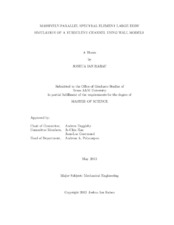| dc.description.abstract | Wall-bounded turbulent flows are prevalent in engineering and industrial applications. Walls greatly affect turbulent characteristics in many ways including production and propagation of turbulent stresses. While computational fluid dynamics can be used as an important design tool, its use is hindered due to the fine-mesh requirements in the near-wall region to capture all of the pertinent turbulent data. To resolve all relevant scales of motion, the number of grid points scales with Reynolds number as N ≈ Re9/4, making it nearly impossible to solve real engineering problems, most of which feature high Reynolds numbers.
A method to help alleviate the resolution requirements is the use of wall models. This method allows for a coarser mesh to be used in which the near-wall region is modeled and the first grid point is placed in the log-law region. The shear stress at the wall is correlated with the velocity at a point outside the near-wall region, drastically reducing the number of elements required and reducing the computational time and cost of the simulation.
The goal of this study was to test the speed increase and element reduction capabilities of combining a wall function solution with the massively-parallel, spectral element solver, Nek5000, and verify the method using a turbulent channel simulation. The first grid point is placed at y+ = 100, in the log-law region, for Reτ = 950 and the sub-grid scales are modeled using a dynamic Smagorinski model. The results are then compared to a DNS performed by Jimenez and Hoyas for model verification. | en |


